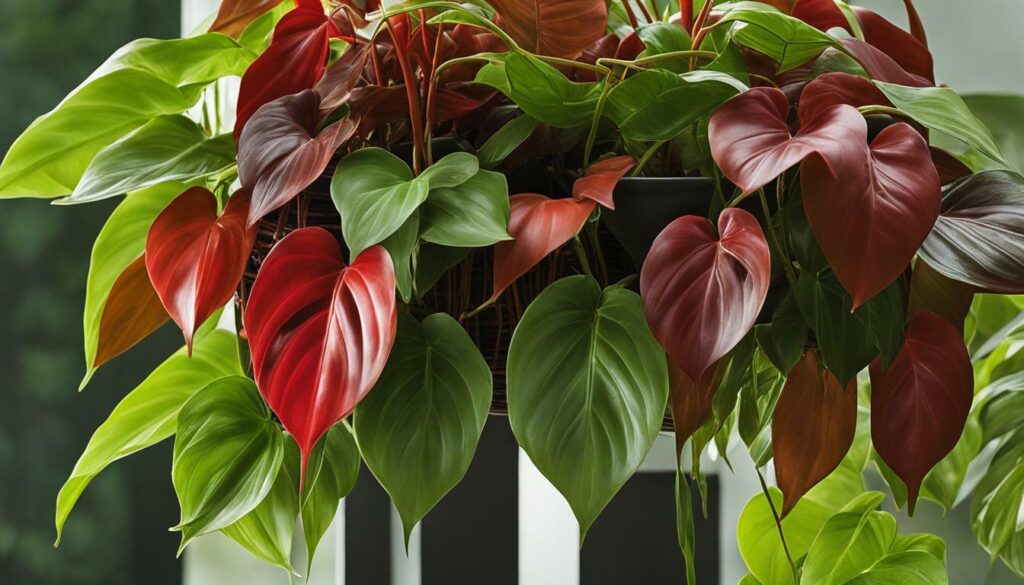Philodendron ‘Micans’ is a popular houseplant known for its velvety, heart-shaped leaves and trailing growth habit. This indoor plant has gained popularity among plant enthusiasts for its unique aesthetic and relatively low maintenance requirements. If you’re looking to add a touch of lush greenery to your home, Philodendron ‘Micans’ is an excellent choice.
Table of Contents
ToggleKey Takeaways:
- Philodendron ‘Micans’ is a popular houseplant with velvety, heart-shaped leaves and trailing growth habit.
- It thrives in bright to medium indirect light and well-draining soil rich in organic matter.
- Watering should be done once the top 2-3 inches of soil have dried out to avoid overwatering.
- Fertilize the plant lightly during the spring and summer with a balanced all-purpose fertilizer.
- Regular pruning helps maintain the plant’s shape and prevents leggy growth.
Now that we’ve introduced the captivating Philodendron ‘Micans’, let’s delve deeper into its care and maintenance. Understanding the specific needs of this plant will ensure its health and longevity in your indoor space.
Understanding Philodendron Varieties
Philodendron plants come in a variety of forms, but the ‘Micans’ variety stands out with its lush trailing vines and attractive foliage. This variety is a favorite among plant lovers due to its unique characteristics and easy care requirements. The ‘Micans’ is known for its velvety, heart-shaped leaves that cascade down, creating a stunning display in hanging baskets or when trained to climb up a trellis.
One of the reasons why trailing plants like Philodendron ‘Micans’ are highly sought after is their ability to add a touch of greenery to any space. Their long vines gracefully drape over shelves, desks, or bookcases, bringing life and beauty to any room. Whether you’re an experienced plant parent or just starting your indoor gardening journey, the ‘Micans’ variety is sure to captivate you with its elegant trailing growth habit.
Table: Popular Philodendron Varieties
| Variety | Description |
|---|---|
| Philodendron ‘Micans’ | Velvety, heart-shaped leaves with trailing vines |
| Philodendron ‘Brasil’ | Green leaves with yellow stripes |
| Philodendron ‘Birkin’ | Dark green leaves with striking white pinstripes |
| Philodendron ‘Pink Princess’ | Dark green leaves with pink variegation |
These varieties are just a few examples of the wide range of Philodendron plants available. Each variety has its own unique characteristics and can bring a touch of nature and beauty into your home. Whether you prefer lush trailing vines or variegated foliage, there is a Philodendron variety that will suit your preferences and style.
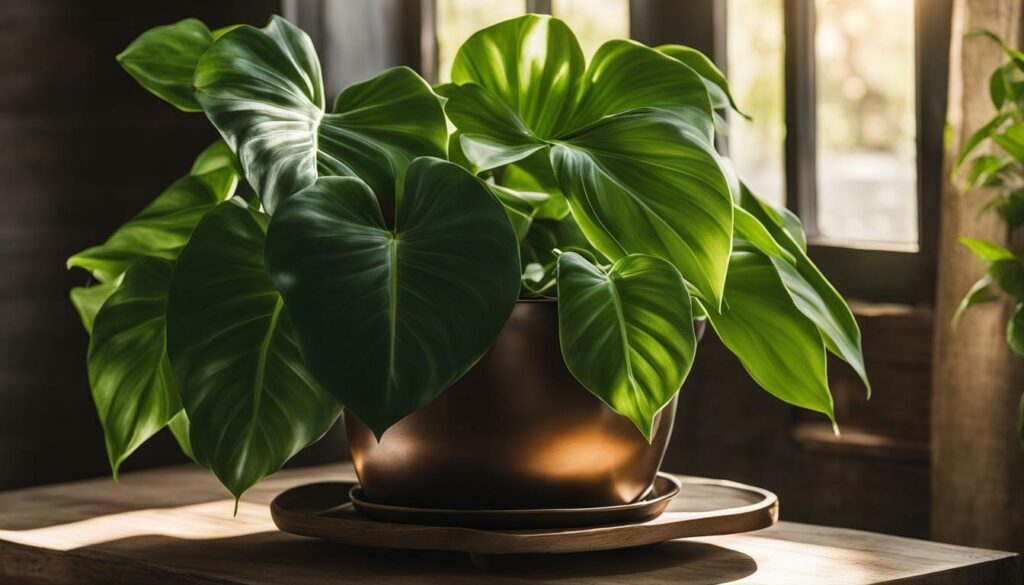
To ensure the healthy growth of Philodendron ‘Micans’, it is crucial to provide it with the right amount of light and a suitable soil environment. This popular houseplant thrives in bright to medium indirect light, making it an excellent choice for indoor gardening. Placing your Philodendron ‘Micans’ near a east or west-facing window is ideal, as it will receive enough light without being exposed to direct sunlight, which can scorch its delicate leaves.
When it comes to soil, Philodendron ‘Micans’ prefers a well-draining mixture that is rich in organic matter. A blend of potting soil, peat moss, and perlite can be a great option. The soil should be loose enough to allow excess water to drain out, preventing root rot. It’s important to note that compacted soil can hinder the plant’s growth and overall health.
As a low-maintenance indoor plant, Philodendron ‘Micans’ can tolerate a wide range of humidity levels. However, it tends to thrive in moderate humidity conditions. A humidity level of around 50% is generally ideal, but it can adapt to lower household humidity levels as well. If your home is particularly dry, you can increase the humidity around the plant by placing a tray filled with water near the plant or by using a humidifier.
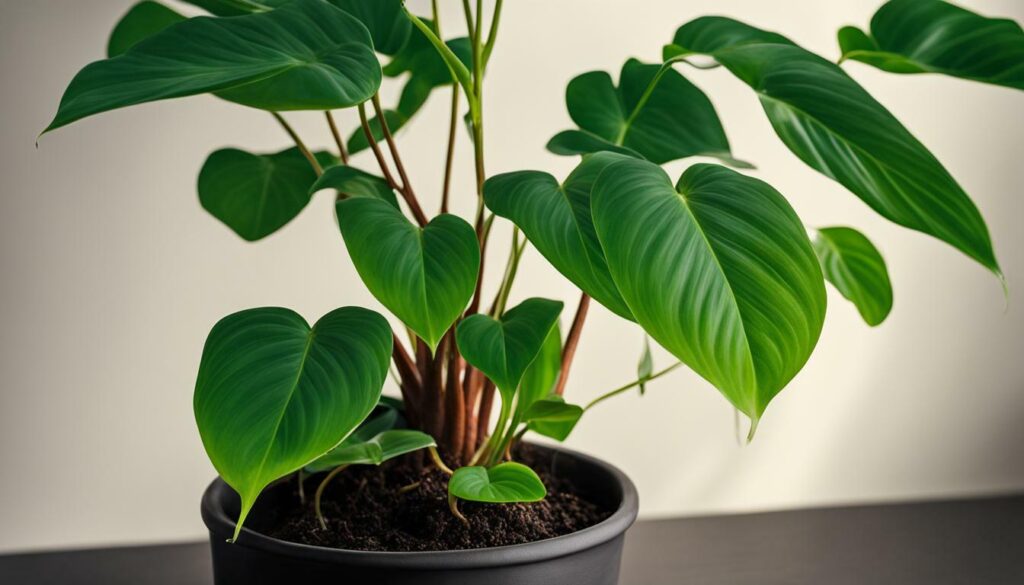
| Light Conditions | Soil Conditions |
|---|---|
| Bright to medium indirect light | Well-draining soil rich in organic matter |
| Avoid direct sunlight | Blend of potting soil, peat moss, and perlite |
Providing the right amount of light and creating a suitable soil environment are essential factors in successfully caring for your Philodendron ‘Micans’. By following these tips, you can ensure that your plant thrives and remains a beautiful addition to your indoor garden.
Watering and Humidity Tips
Proper watering and humidity levels play a significant role in the health and vitality of Philodendron ‘Micans’. This indoor plant thrives when its soil is allowed to dry out slightly between waterings. Overwatering can lead to root rot and other issues, so it’s crucial to avoid keeping the soil constantly wet. To determine when to water, simply check the top 2-3 inches of soil with your finger. If it feels dry to the touch, it’s time to water.
When watering, it’s important to provide thorough hydration, allowing water to flow through the pot’s drainage holes. This helps flush out any excess salts or minerals that may accumulate in the soil. Remember to empty the saucer underneath to prevent the plant from sitting in standing water, which can lead to root rot.
In terms of humidity, Philodendron ‘Micans’ appreciates moderate to high humidity levels, but it can tolerate average household conditions. To increase humidity, you can place the pot on a tray filled with water and pebbles, ensuring the water level is below the bottom of the pot. As the water evaporates, it creates a humid microenvironment around the plant. Alternatively, you can use a humidifier or group your plants together to create a humid microclimate.
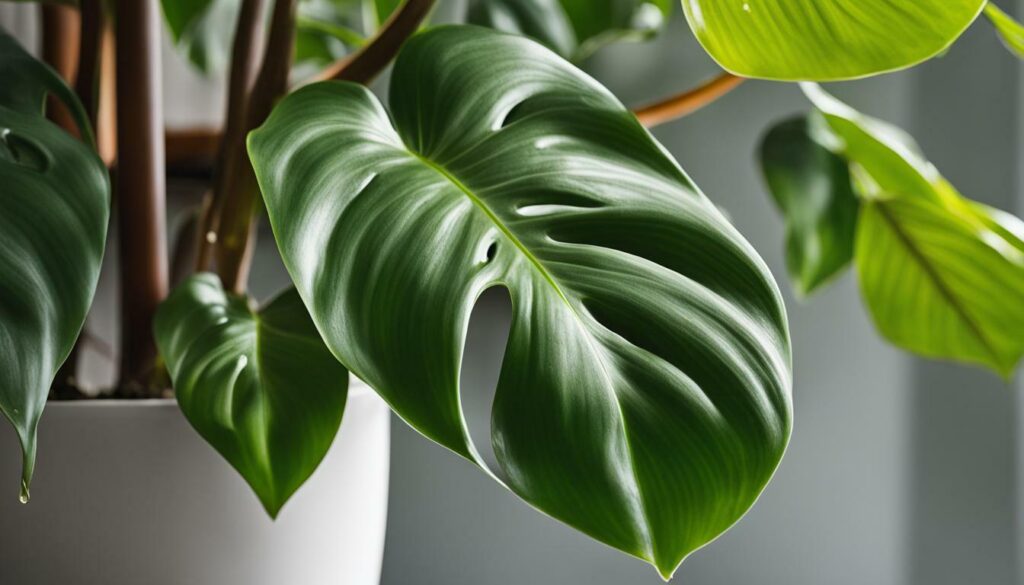
By following these watering and humidity tips, you can ensure that your Philodendron ‘Micans’ thrives and remains healthy. Regularly monitoring the soil moisture and providing adequate humidity will help prevent common issues and promote vibrant growth.
Fertilization for Growth
Providing the right nutrients through fertilization can help boost the growth and vigor of your Philodendron ‘Micans’. This popular indoor plant responds well to light fertilization during the spring and summer months, when it is actively growing. A balanced all-purpose fertilizer is recommended to ensure that your Philodendron ‘Micans’ receives the necessary nutrients for healthy development.
When fertilizing, it is essential to follow the instructions provided on the fertilizer packaging. Over-fertilization can lead to nutrient burn and damage the plant’s roots. It is best to err on the side of caution and apply fertilizer at half the recommended strength. This will prevent any potential harm and allow your Philodendron ‘Micans’ to thrive.
The frequency of fertilization depends on the specific fertilizer you choose and the growth rate of your plant. Typically, fertilizing once every two to four weeks during the active growing season is sufficient. Remember to adjust the frequency and amount of fertilizer based on the plant’s response and any changes in growth patterns.
As always, it’s important to monitor your Philodendron ‘Micans’ closely and pay attention to its overall health. Regularly inspect the leaves for signs of nutrient deficiency or burn. Adjust the fertilization schedule accordingly and make any necessary modifications to ensure your plant remains happy and healthy.

Pruning is an essential practice for keeping your Philodendron ‘Micans’ in shape and ensuring its overall well-being. This houseplant, known for its velvety, heart-shaped leaves and trailing growth habit, can benefit greatly from regular pruning. Trimming back overgrown stems and removing dead or yellowing leaves not only helps maintain its aesthetic appeal but also promotes healthier growth.
When pruning your Philodendron ‘Micans’, it’s important to use clean, sharp gardening shears to make clean cuts. Start by identifying any overgrown or leggy stems and trim them back to stimulate new growth. Additionally, remove any damaged or discolored leaves, as these can indicate underlying issues such as pests or disease.
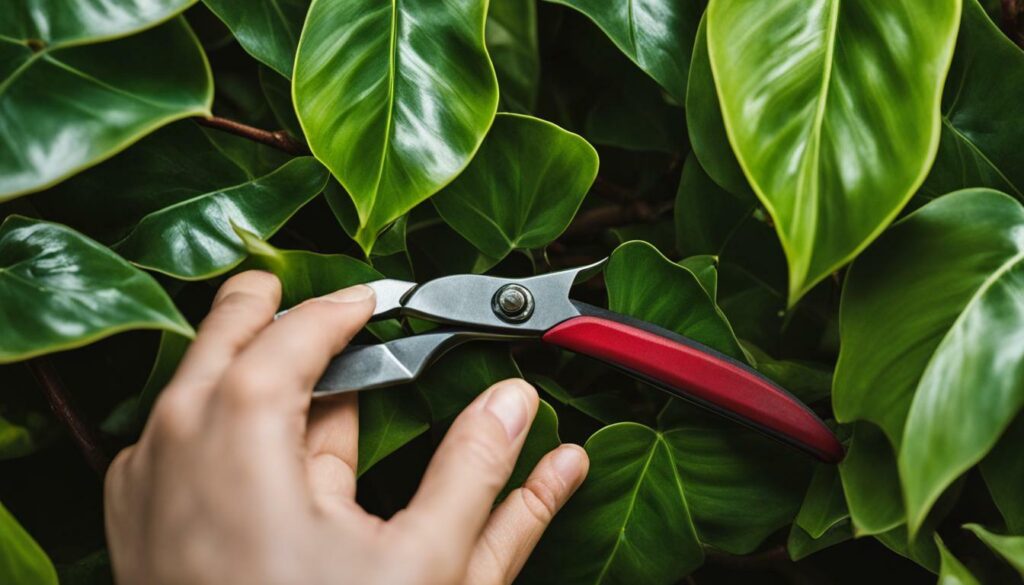
In addition to shaping your plant, pruning also improves air circulation and prevents the accumulation of dust and debris on the leaves. This can help prevent pest infestations and ensure that your Philodendron ‘Micans’ remains healthy and vibrant. Remember to clean your gardening shears after each use to prevent the spread of diseases, and always discard any infected plant material in sealed bags to avoid contamination.
Regular pruning, along with proper watering, fertilization, and light conditions, will contribute to the overall success of your Philodendron ‘Micans’ as a beautiful addition to your indoor garden. Ensure that you monitor your plant’s growth regularly and adjust your pruning routine accordingly. By investing a little time and effort into pruning, you can enjoy a lush and well-maintained Philodendron ‘Micans’ that will thrive for years to come.
Propagation Made Easy
If you’re a plant enthusiast looking to expand your Philodendron collection, propagating Philodendron ‘Micans’ through stem cuttings is a simple and rewarding method. This beautiful houseplant can easily be multiplied, allowing you to share its beauty with friends and family or fill your home with more greenery.
To propagate Philodendron ‘Micans’, start by selecting a healthy and mature stem. Using a sharp, clean pair of pruning shears, cut a section of the stem just below a node, which is where the leaves and roots emerge. Aim for a cutting that is around 4-6 inches long, ensuring it has at least two nodes.
Next, remove the lower leaves, leaving only a few at the top. This will help redirect the plant’s energy towards root development. You can dip the cut end of the stem in rooting hormone powder to encourage faster root growth, although this step is optional.
Place the stem cutting in a glass or container filled with clean water, ensuring that the nodes are submerged. Keep the container in a well-lit area, away from direct sunlight. Change the water every few days to prevent stagnation and bacterial growth.
After a few weeks, you should start seeing roots emerging from the nodes of the stem cutting. Once the roots are around 1-2 inches long, it’s time to transfer the cutting into a pot with well-draining soil. Gently plant the cutting, burying the nodes just below the soil surface, and water thoroughly.
Remember to provide the newly propagated Philodendron ‘Micans’ with the same care and conditions as the parent plant. With time and proper care, your new plant will grow and flourish, adding a touch of beauty to your indoor garden.
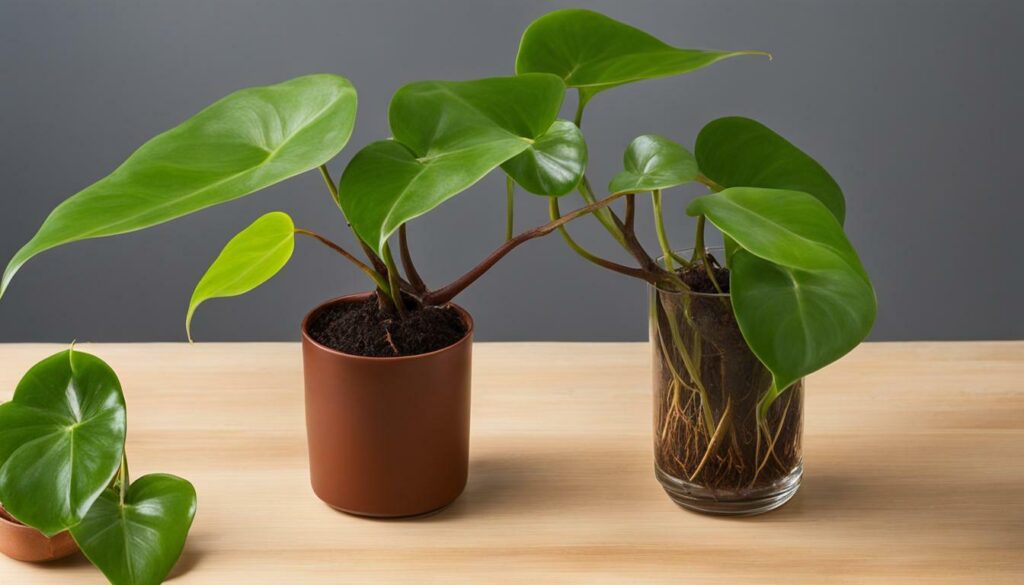
| Propagation Method | Difficulty Level |
|---|---|
| Stem Cuttings in Water | Easy |
| Stem Cuttings in Soil | Moderate |
| Division | Difficult |
Pest Control and Prevention
Regular pest control and prevention are essential in keeping your Philodendron ‘Micans’ free from common pests like scale, aphids, and mealybugs. These pests can cause damage to the leaves, hinder growth, and even spread to other plants in your indoor garden.
To combat these pests, it is important to regularly inspect your Philodendron ‘Micans’ for any signs of infestation. Look for sticky residue, discolored leaves, or the presence of tiny insects. If you notice any of these signs, it is crucial to take immediate action.
One effective method of pest control is to gently wipe down the leaves with a damp cloth or sponge to remove any pests or eggs. You can also use insecticidal soap or neem oil spray, following the instructions on the packaging for proper application. These organic solutions help eliminate pests while being safe for your plant and the environment.
Prevention is key to maintaining a healthy Philodendron ‘Micans’. Keep your plant in a clean and well-ventilated area to discourage pest infestations. Avoid overwatering, as excess moisture can attract pests. Additionally, regularly inspect any new plants before introducing them to your indoor garden to prevent the spread of pests.
| Pest | Symptoms | Treatment |
|---|---|---|
| Scale | Presence of small, oval, or round bumps on leaves, sticky residue on leaves, and yellowing or wilting foliage. | Remove scales by gently scraping them off with a soft brush or cloth. Use insecticidal soap or neem oil spray. |
| Aphids | Distorted or curled leaves, sticky residue on leaves, and the presence of small green, brown, or black insects on the plant. | Remove aphids by spraying the plant with a strong stream of water. Use insecticidal soap or neem oil spray. |
| Mealybugs | White, cotton-like masses on stems, leaves, and leaf axils, stunted growth, and yellowing foliage. | Remove mealybugs by dabbing them with a cotton swab soaked in rubbing alcohol. Use insecticidal soap or neem oil spray. |
Troubleshooting Common Issues
When caring for Philodendron ‘Micans’, it’s important to be aware of common issues that may arise and know how to address them effectively. By recognizing and addressing these problems promptly, you can ensure the health and vitality of your indoor plants.
One common issue is overwatering, which can lead to root rot and the development of fungal diseases. To prevent this, make sure to allow the top 2-3 inches of soil to dry out before watering. Use well-draining soil, such as a mixture of potting soil and perlite or orchid bark, to ensure proper moisture levels. You can also check the moisture levels by sticking your finger into the soil – if it feels dry, it’s time to water.

Pests can also be a common issue when it comes to Philodendron ‘Micans’. The most common pests include scale, aphids, and mealybugs. These pests can be controlled by using insecticidal soap or neem oil. Regularly inspect your plant for any signs of infestation, such as sticky residue, distorted leaves, or tiny insects. If you notice any pests, isolate the affected plant and treat it immediately to prevent the infestation from spreading.
Common issues related to improper lighting can be identified through these signs:
- Yellowing or browning leaves
- Stunted growth
- Leggy or elongated stems
If your Philodendron ‘Micans’ exhibits any of these symptoms, it may be receiving too much or too little light. Adjust the placement of your plant accordingly. If the leaves are pale or sparse, it may be an indication that the plant needs more light. Move it closer to a window or provide supplemental artificial lighting. On the other hand, if the leaves are turning brown and crispy, it may be getting too much direct sunlight. Move it further away from the window or provide a sheer curtain to filter the light.
By addressing these common issues, you can ensure that your Philodendron ‘Micans’ thrives and adds beauty to your indoor space. Regular monitoring, proper care, and prompt action will help keep your plants healthy and vibrant.
Conclusion
Caring for and maintaining Philodendron ‘Micans’ can be a rewarding experience, and by following the recommended tips and techniques, you can enjoy a thriving and beautiful houseplant. This popular indoor plant, known for its velvety, heart-shaped leaves and trailing growth habit, adds a touch of greenery and elegance to any space.
To ensure the health and longevity of your Philodendron ‘Micans’, it is important to provide it with the right conditions. Place your plant in a location where it can receive bright to medium indirect light, as this will promote optimal growth. Additionally, make sure to use well-draining soil that is rich in organic matter to provide the plant with the nutrients it needs.
When it comes to watering, it is essential to strike a balance. Wait until the top 2-3 inches of soil have dried out before watering, as overwatering can lead to root rot. Philodendron ‘Micans’ thrives in warm temperatures and can tolerate average household humidity levels, but it is always beneficial to provide some additional moisture through misting or a humidifier.
Regular pruning is key to maintaining the shape and overall health of your Philodendron ‘Micans’. By trimming back leggy growth and removing dead leaves, you can encourage new growth and keep your plant looking its best. Additionally, propagating Philodendron ‘Micans’ through stem cuttings is a simple and effective way to expand your plant collection.
While caring for your Philodendron ‘Micans’, it is important to keep an eye out for common pests such as scale, aphids, and mealybugs. Regularly inspect your plant and take appropriate measures to control and prevent infestations. Lastly, be aware that Philodendron ‘Micans’ is toxic to both cats and dogs, so it is important to keep it out of their reach.
FAQ
How often should I water my Philodendron ‘Micans’?
Watering should be done once the top 2-3 inches of soil have dried out. Avoid overwatering as it can lead to root rot.
What kind of light does Philodendron ‘Micans’ need?
Philodendron ‘Micans’ thrives in bright to medium indirect light. Avoid placing it in direct sunlight as it can scorch the leaves.
How frequently should I fertilize my Philodendron ‘Micans’?
Light fertilization with a balanced all-purpose fertilizer during the spring and summer can help boost its growth. Follow the packaging instructions for the specific fertilizer you choose.
How do I propagate Philodendron ‘Micans’?
Philodendron ‘Micans’ can be easily propagated through stem cuttings. Simply cut a healthy stem below a node, remove the lower leaves, and place it in water or a well-draining potting mix until roots develop.
Is Philodendron ‘Micans’ toxic to pets?
Yes, Philodendron ‘Micans’ is toxic to both cats and dogs. Keep it out of reach of pets to avoid ingestion.
How can I prevent pests from affecting my Philodendron ‘Micans’?
Regularly checking your plant for common pests like scale, aphids, and mealybugs can help identify and address infestations early on. Maintaining good airflow around the plant and practicing good hygiene can also help prevent pest problems.
What are common issues that can arise with Philodendron ‘Micans’?
Common issues with Philodendron ‘Micans’ are usually related to improper watering, drainage, or lighting. It’s important to ensure the plant is watered correctly, has well-draining soil, and receives appropriate light levels.
